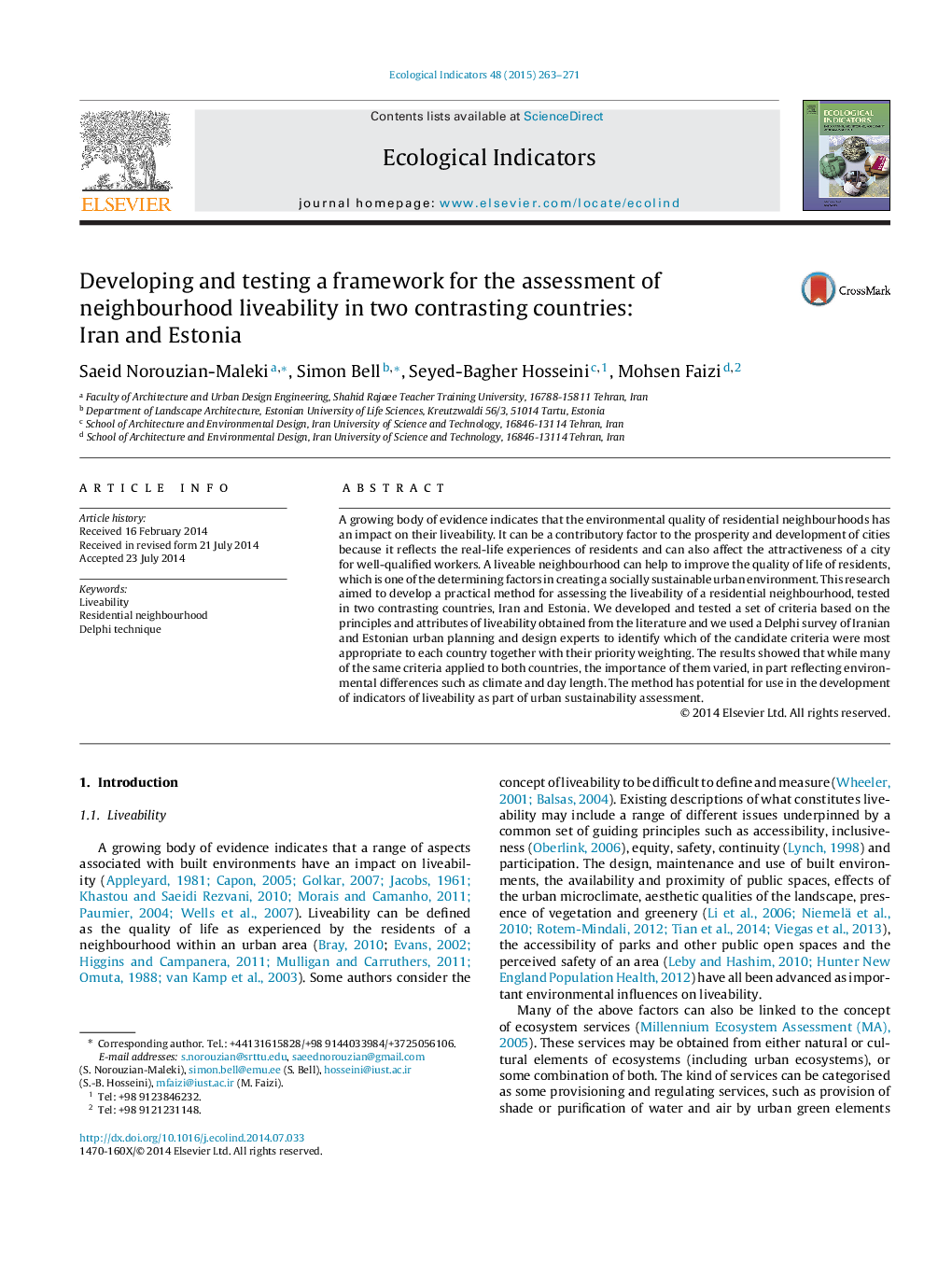| کد مقاله | کد نشریه | سال انتشار | مقاله انگلیسی | نسخه تمام متن |
|---|---|---|---|---|
| 6295001 | 1617153 | 2015 | 9 صفحه PDF | دانلود رایگان |
عنوان انگلیسی مقاله ISI
Developing and testing a framework for the assessment of neighbourhood liveability in two contrasting countries: Iran and Estonia
ترجمه فارسی عنوان
توسعه و آزمایش یک چارچوب برای ارزیابی قابلیت زندگی محله در دو کشور متضاد: ایران و استونی
دانلود مقاله + سفارش ترجمه
دانلود مقاله ISI انگلیسی
رایگان برای ایرانیان
کلمات کلیدی
قابلیت زندگی، محله مسکونی، تکنیک دلفی،
ترجمه چکیده
رو به رشد مجموعه شواهد نشان می دهد که کیفیت محیط زیست مساجد مسکونی تاثیر می گذارد. این می تواند عامل مؤثر در رفاه و توسعه شهرها باشد، زیرا این امر تجارب واقعی زندگی ساکنان را منعکس می کند و همچنین می تواند بر جذابیت یک شهر برای کارگران واجد شرایط تأثیر گذارد. همسایگی قابل زندگی می تواند به بهبود کیفیت زندگی ساکنان کمک کند، که یکی از عوامل تعیین کننده در ایجاد یک محیط شهری پایدار اجتماعی است. این پژوهش با هدف توسعه یک روش عملی برای ارزیابی قابلیت زندگی یک محله مسکونی، آزمایش شده در دو کشور متضاد، ایران و استونی. ما مجموعه ای از معیارها را بر مبنای اصول و ویژگی های زندگی پذیری به دست آمده از ادبیات توسعه دادیم و مورد آزمایش قرار دادیم و از یک بررسی دلفی از کارشناسان برنامه ریزی شهری و استانی در ایران و استونی استفاده کردیم تا مشخص شود کدام معیار نامزد برای هر کشوری مناسب تر است وزن اولویت آنها نتایج نشان داد که در حالیکه بسیاری از معیارهای مشابه برای هر دو کشور مورد استفاده قرار می گرفت، اهمیت آنها متفاوت بود، به طوری که منعکس کننده تفاوت های زیست محیطی مانند آب و هوا و طول روز بود. این روش پتانسیل برای استفاده در توسعه شاخص های زندگی را به عنوان بخشی از ارزیابی پایداری شهری دارد.
موضوعات مرتبط
علوم زیستی و بیوفناوری
علوم کشاورزی و بیولوژیک
بوم شناسی، تکامل، رفتار و سامانه شناسی
چکیده انگلیسی
A growing body of evidence indicates that the environmental quality of residential neighbourhoods has an impact on their liveability. It can be a contributory factor to the prosperity and development of cities because it reflects the real-life experiences of residents and can also affect the attractiveness of a city for well-qualified workers. A liveable neighbourhood can help to improve the quality of life of residents, which is one of the determining factors in creating a socially sustainable urban environment. This research aimed to develop a practical method for assessing the liveability of a residential neighbourhood, tested in two contrasting countries, Iran and Estonia. We developed and tested a set of criteria based on the principles and attributes of liveability obtained from the literature and we used a Delphi survey of Iranian and Estonian urban planning and design experts to identify which of the candidate criteria were most appropriate to each country together with their priority weighting. The results showed that while many of the same criteria applied to both countries, the importance of them varied, in part reflecting environmental differences such as climate and day length. The method has potential for use in the development of indicators of liveability as part of urban sustainability assessment.
ناشر
Database: Elsevier - ScienceDirect (ساینس دایرکت)
Journal: Ecological Indicators - Volume 48, January 2015, Pages 263-271
Journal: Ecological Indicators - Volume 48, January 2015, Pages 263-271
نویسندگان
Saeid Norouzian-Maleki, Simon Bell, Seyed-Bagher Hosseini, Mohsen Faizi,
